We are sitting on the roof of a Nepali bus; myself, my brother Will, and our guide Sam, perched on luggage railings and holding onto the bus’ hard outer casing. We attempt to secure both ourselves and our luggage as the packed vehicle shudders along uneven roads at 60kph; horn blaring as it approaches blind corners, sometimes on the wrong side of the road.
We pull in near Dhampus where our trio scale the ladder back down to solid ground, haul our backpacks on, and we’re off… almost. A few Tibetan tradeswomen greet us at the foot of the mountain, selling friendship bracelets “for good luck”. I politely decline but my brother arms himself with one, and we begin our ascent. There are a lot of steps here, which I imagine will taper out into a hillside incline at some point. They never do.
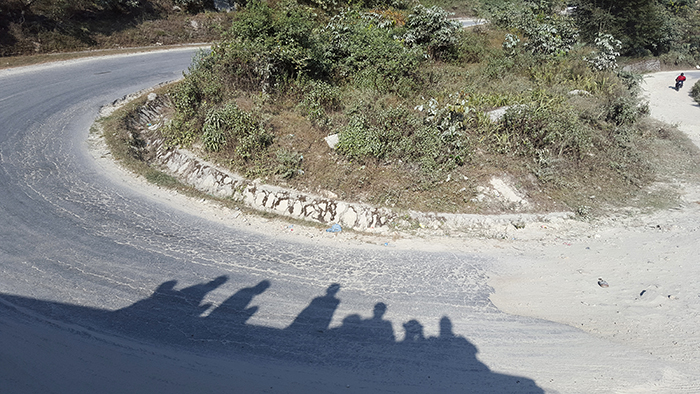
In the Himalayan foothills, steep steps are interspersed with quaint mountain villages and teahouses; the smell of campfires drift from each homestead as food is cooked and water boiled. The scenery here is reminiscent of landscapes seen in Lord of the Rings, and the ancient farming practices give you a first-hand insight into life before the industrial revolution. You see millet being thrashed, straw being wound into stacks or spread across fields, buffalo and yaks working the land as chickens and dogs scavenge for scraps. The frequent sound of bells ring through the valleys as donkeys transport goods or goats ascend the mountain, herded by a wailing shepherd.
Opposite our first teahouse, 1650 metres high, a picnic has begun. Nepali teenagers climb up to party and will later stumble their way back down, through dark mountain steps, back to their homes. The older generation of mountaineers watch the hip-hop-styled revellers with steely eyes, unmoved by the jovial proceedings as their neighbours thrash millet. The difference between these two groups of Nepali’s is quite staggering.
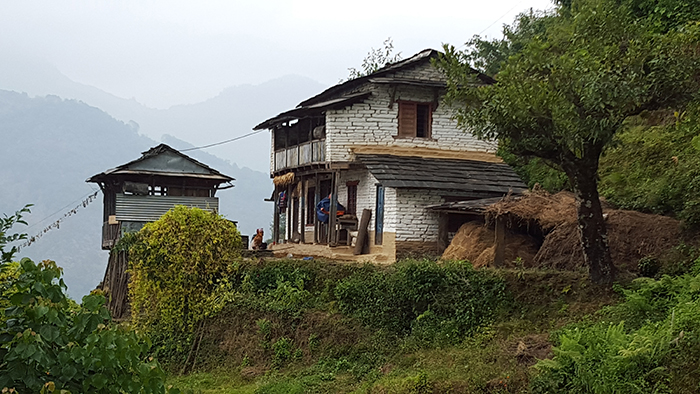
After a four-hour climb we reach Pothana; the guesthouse is basic but it’s a roof over our heads. The Nepali fuel crisis means there is no hot water for showering but they kindly boil a bucket of water over the fire to serve as a shower. Primitive or not, I’m grateful for the opportunity to warm up a little as the temperature is quickly dropping. There’s a toasty fire burning in the restaurant and as we gravitate towards that we sample some home-made millet wine. It tastes distinctly of beetroot and is warm and strong, but not my cup of tea.
The next morning we spot Annapurna through the mist – the first snow-topped mountain range we’ve seen. A hard light falls through the tall trees around us as we discuss trekking routes. We were heading to Mardi Himal, but we’re now changing direction to include the hot springs in the limited time we have. We’ve got to reach it today, and then we will decide on our final destination.
We stop for lunch once and tea once again, but time is ticking and the spring is still so far away. The guide suggests we stop sooner because I look tired and he suggests it’s because I’m a woman. I don’t use my gender as an excuse and he certainly doesn’t have the right to – I’m more determined than ever to make it there! We keep going and we just don’t stop. No rests, no teas, nothing – we need to make it to the hot spring and we need to make it tonight. I lead most of the way, setting a fast pace and purposefully flying in the face of chauvinism.
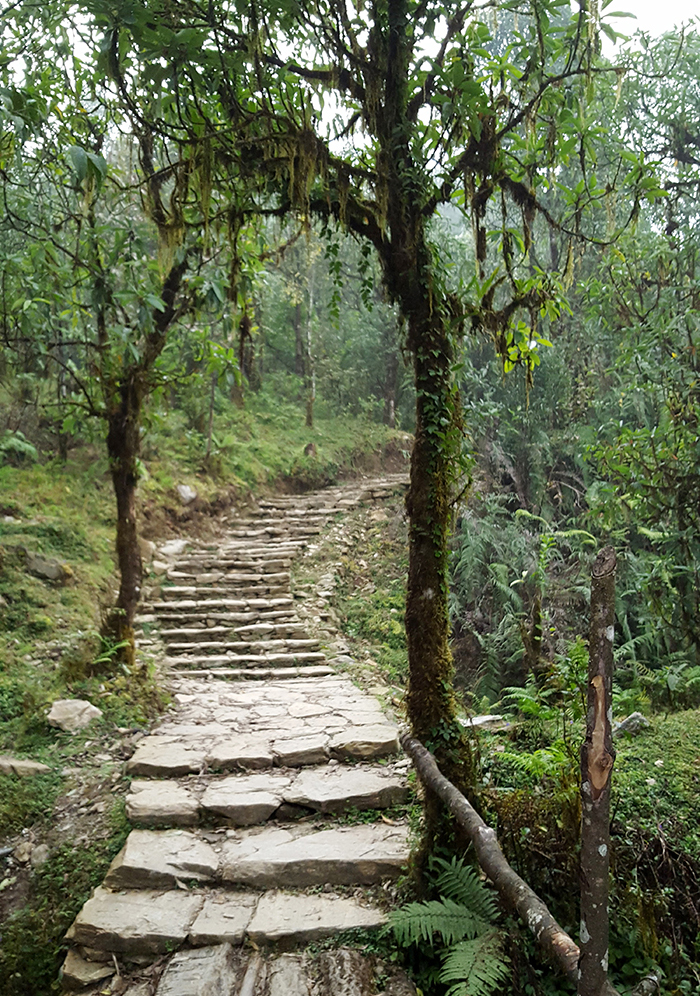
I would say that doing eight hours of stair climbing on your second day trekking is not ideal… the last hour is the killer and the sun sets as we approach the guesthouse. We’ve made it to our destination – Jhinu – but are so exhausted. We don’t fancy the journey down through the jungle to the hot spring. It will have to wait till tomorrow.
The walk to Jhinu was one of the best trails – we saw waterfalls, a watermill, gushing rivers, bouncing suspended bridges, donkey processions, walking hedges blocking our path and buffalos running us off the road – I had to hold onto one as he passed to stop myself falling down the mountainside! We also saw the beautiful iced mountain, Annapurna 2, growing larger and larger as we made tracks. After a morning spent at the hot springs, we only made it past a couple of villages, deciding we wouldn’t have time to go further. We relaxed at Chhomrong, 2177 metres high, enjoying sweet Masala tea and a tasty chicken curry. Lovely!
We took it easy the next day too – my knees were quite painful (from a bad Cambodian massage) and my brother’s ankle wasn’t doing too well either (an old injury). During the walk back down, we were stopped at sunset by a woman carrying rice back home. She, like the porters, carried goods on her back with a band around her forehead to take the strain. She took a shine at my rather expensive blanket and offered us a stay in their family home in exchange for the blanket! They fed us daal bhat, more home-made wine, and showed us music videos (the lady was a local singer) before we retired.
It was popcorn for breakfast, with a tikka blessing. I handed over my blanket in trade, with an extra one as a thanks. They asked for my brother’s blanket too, and – after he agreed – handed us a pricey itemised list of everything, as if the trade never happened (the trade alone made that stay our most expensive). We paid a little extra and left but the guide stayed, only making the situation worse.
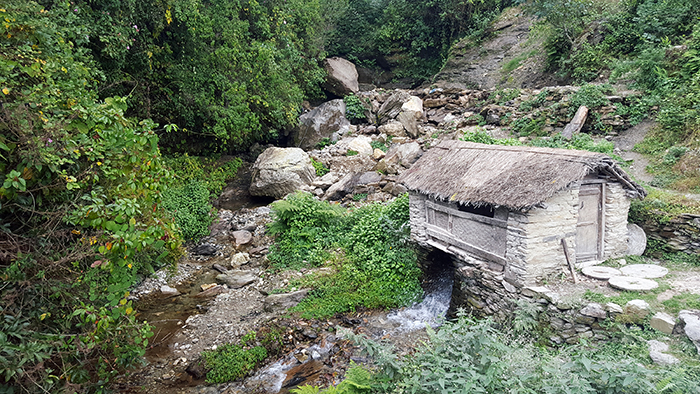
In the end, my brother went back to establish what they wanted – the blankets or the money – and since they took the blankets, he turned to leave. The singer then stole the money our guide had been holding feebly since their argument began. We walked an hour away from that sour turn of events and stopped in a nice, friendly place for breakfast. (Note that experience is in no way characteristic of Nepali hospitality.)
To end the trek, we walked down further and bumped into a former Buddhist monk on the trail, working as a head Sherpa and using his business to rebuild Nepal after the earthquake. After a good natter, we headed onward to catch the local bus. As expected, we boarded the roof. This time we made a bed from the bags around us and chilled out for most of the way, watching the mountainside pass by, its flora either monochrome by the turfed up dust or stretching out into the distance in stunning gradients of blue. Behind me, the snowy mountains became visible; Annapurna, Fishtail and some other unknown beauties. Their peaceful mountain hush gradually gave way to the hustle and bustle of towns and the screech of horns.
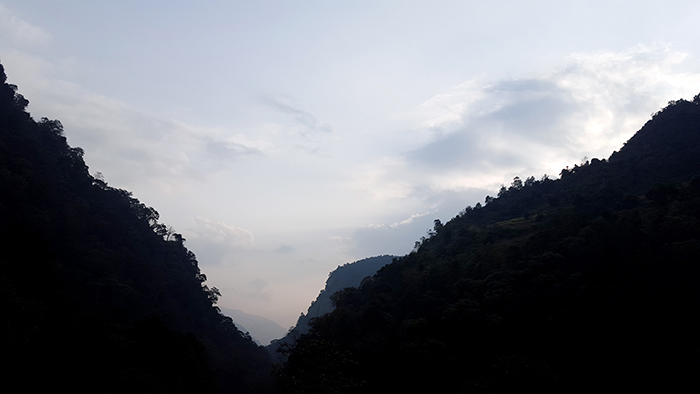
Traffic police stopped our bus half way and herded us from the roof into a full bus; so jam packed that my tall brother had to hang out of the door to avoid stooping. We reached Pokhara; our trek completed. It had been a worthwhile struggle, frequently punctuated with cultural gems and a first-hand look at ancient farming methods.
It is an interesting if not a convenient time to be in Nepal, and it’s a real insight into the true strength of community and humanity. Despite the recent earthquake and current fuel crisis their spirits are still high; and even though prices have risen, it’s still more than affordable for tourists. If you’re up for the challenge, head out to trek in Nepal!
Words + Photos By: Kathryn Pardoe

